Cambria Evans Christensen
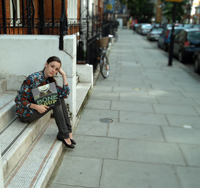
Tell us about Bone Soup and Martha Moth Makes Socks, which were published by Houghton Mifflin. What brought those particular stories and images into your mind?
While studying graphic design at Rhode Island School of Design (RISD), I was able to take a wonderful illustration class called “Picture + Word.” Its entire focus was writing and illustrating children’s books. For our final project we had to present a dummy (a manuscript and sketches in book form) to a panel of editors in Boston. Very soon after that, I had an agent and a book deal for Martha Moth with Houghton Mifflin. The story came from an experience with a pesky moth in my Providence apartment. I pulled out my sweaters for fall, and they were all fine except for my favorite one. I thought, “Why did that moth have to go shopping in my closet?” That sparked the idea of a moth that could eat a sweater in a single sitting.
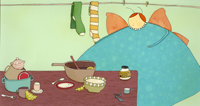
Bone Soup was a longer process. I knew I wanted to write a Halloween story, but I struggled with coming up with ideas. While traveling in Cuzco, Peru, I came across a horrid soup with eyeballs and bones at an outdoor market. I called to my husband, “Come see this bone soup!” Saying those words out loud made the whole idea fall into place. I was excited but fairly certain someone must have already written a spooky version of Stone Soup, because it seemed so natural. But luckily no one had yet! So, I sat down, wrote the first draft in one day, and sent it to my agent and editor.
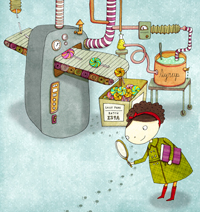
It’s evident from both books that you have a very unique style that ranges from the craft-like to the surreal—a mix of the vintage and the contemporary. What can you tell us about how you see your style and in what way it expresses who you are as an artist?
My illustrations reflect the things I’m interested in. I like paper ephemera, patterns, typography, and nearly anything vintage. Then there is my love of modern minimalism which shows itself in my slightly OCD line work—where everything is contained and the same line weight. I think my style is a continuation of the drawings I’ve made since I was little—but hopefully getting better!
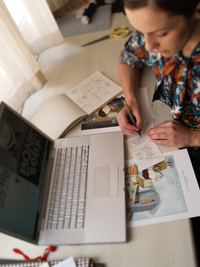
You’ve done design work for some pretty big companies—Martha Stewart, L.L. Bean, Kmart, Reader’s Digest, Wizards of the Coast, Habitat for Humanity. How different is the big-name, corporate atmosphere from your more creative work with your children’s books? Which do you prefer?
I used to work full-time for Martha Stewart as an art director, and have continued to freelance for them as well as other clients. My jobs are a mixture of illustration, product, and graphic design. Doing children’s books and design for companies are both creative and I like switching between the two because they require using design to solve problems, with very different results.
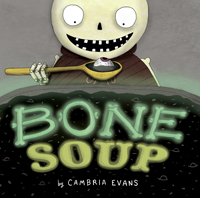
You grew up in Utah but have lived in New York and now in London. How does the cosmopolitan atmosphere compare to what you grew up with?
I’m originally from Virginia and spent most of my summers there, so the East Coast feels like home. The variety of food in metropolitan areas is amazing. There are great specialty stores, restaurants and farmers markets. I’ve always been a bit of a food snob, but after New York I am even worse. I think big cities feel more like a neighborhood to me because everyone is out walking, playing in the park and you see the same shop owners and people on the subway/tube. I especially love that I can walk within a few blocks to do all of my errands. Our little branch in Brooklyn, Bushwick 1st, may be small, but it is fantastic—the people who show up want to be there, and because of that, there is a lot of camaraderie.
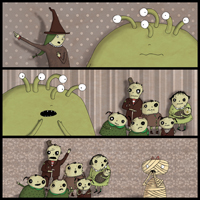
The drawbacks to the city are that it is very expensive, doing basic things like laundry or parking the car can take forever, and everyone is always working so it’s hard to get together with people. There are plenty of things I like about Utah. I regard it with fondness, and I certainly miss friends, family, and the thrift stores. However, I don’t miss the dry, hot summers, the lack of food options, and the fact that you have to drive everywhere.
What would you say are the positives and negatives in doing freelance work? How has it compared with your more steady jobs?
The big positive with freelance is that I have the ability to work anywhere. I was just in Amsterdam, and in between sightseeing I was able to work on deadlines. Plus, I have the freedom to work on all kinds of projects. In one day I could be doing an illustration for a poster, a logo for a non-government organization, a product design for a craft line, and writing a manuscript. The three major drawbacks are that I never know when the next check is going to arrive, I have to pay my own ridiculously expensive health insurance (which doesn’t even cover much), and there are no real vacations or holidays, as I am always working.
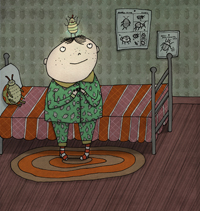
What creative things do you like to do in your free time? What are your hobbies?
I used to spend hours drawing little characters in sketchbooks, but that feels like work now and I try to avoid overworking my arm. So, to relax, I read, watch TiVo, cook or bake, and travel. Also, because of my many allergies and gluten-free requirements, I spend quite a bit of time experimenting in the kitchen and coming up with new recipes.

How has the gospel affected your artistic life?
Because I have the gospel in my life, I am happy, and I think that shows through in my work. I write and draw things I find funny and hope others find them funny too. The only time being LDS has affected my work directly was when I turned down a lucrative job designing for advertising firms and products that go against the Word of Wisdom or my morals.
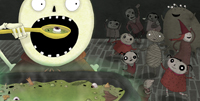
Where do you want to be several years down the road?
I hope to continue doing what I love: working on books (hopefully with a larger print run and audience) and doing design. I also wouldn’t mind traveling more.
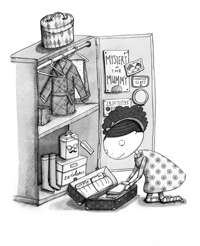
What advice would you give to those who are trying to break into your field?
For design, work on a portfolio that shows good concepts, a clear understanding of typography, and the ability to solve problems by showing process. For children’s book illustration, work on a portfolio that is consistent, shows an ability to draw the same characters in different poses, and is not a copy of someone else’s style. ❧
